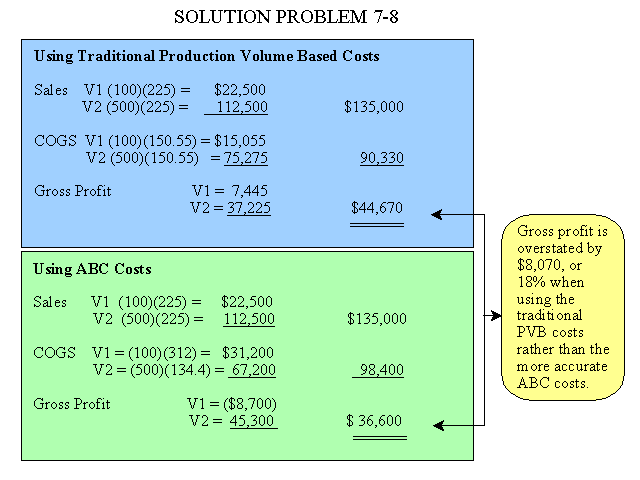
Provided by James R. Martin, Ph.D., CMA
Professor Emeritus, University of South Florida
MAAW's Textbook Chapter
7 | MAAW's Textbook Main Page
This problem extends the Company A illustration in Chapter 7. The summary Exhibit 7-9 is reproduced below for convenience.
| EXHIBIT 7-9 COMPANY A ABC AND PVB UNIT COST COMPARISONS |
||||||
| Cost Pool or Category | ABC Unit Cost V1 | PVB Unit Cost V1 | Amount V1 PVB Unit Cost is Understated |
ABC Unit Cost V2 | PVB Unit Cost V2 | Amount V2 PVB Unit Cost is Overstated |
| 1. Non production volume related |
$222 |
$60.55 | $161.45 | $44.40 | $60.55 | $16.15 |
| 2. Production volume related | 30 | 30.00 | 0 | 30.00 | 30.00 | 0 |
| Total overhead | $252 | $90.55 | $161.45 | $74.40 | $90.55 | $16.15 |
| 3. Direct material | 50 | 50.00 | 0 | 50.00 | 50.00 | 0 |
| 4. Direct labor | 10 | 10.00 | 0 | 10.00 | 10.00 | 0 |
| Totals | $312 ==== |
$150.55 ====== |
$161.45 ====== |
$134.40 ====== |
$150.55 ====== |
$16.15 ===== |
1. Suppose Company A sets the sales price of each product at $225 to provide a markup of approximately 50% over the traditional production volume based unit cost of $150.55. What effect will the cost distortions have on net income if the company sells 100 units of V1 and 500 units of V2 at this price?
2. Relate your findings in question 1 to the controversy over whether ABC should be used as a replacement for the company’s general ledger system or as a separate stand alone system for management decision purposes.
________________________________________________
1. Effect of cost distortions.

2. The argument that ABC is not needed for external reporting is based on an underlying assumption that most of the inventory will be sold during the period. However, this illustration shows that significant inventory changes (increase in V2 in this illustration), can have a material effect on financial performance and perhaps the decisions made by external users.
Based on the traditional PVB cost allocations Company A management would not know that V1 is unprofitable. But consider what gross profit would be if Company A used ABC and marked both products up by 50% over ABC costs. Then the prices would be V1 (1.5)($312) = $468 and V2 = (1.5)($134.4) = $202 rounded to dollars. Sales would be V1 ($468)(100) + V2 ($202)(500) = $147,800, and gross profit would be $147,800 - $98,400 = $49,400. By having an accurate picture of their product costs, Company A management could increase gross profit by $49,400 - $36,600 = $12,800, or by nearly 35% (i.e., 12,800/36,600 = .3497). Of course increasing the price of V1 from $225 to $468 might not be acceptable to the customer, but Company A management would have a very good case for raising the price, or perhaps finding other alternatives.